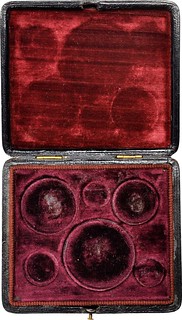
PREV ARTICLE
NEXT ARTICLE
FULL ISSUE
PREV FULL ISSUE
SELECTIONS FROM THE OCTOBER 2015 STACK'S BOWERS RARITIES SALE
Here are a few lots that caught my eye in the upcoming Stack's Bowers Rarities Sale (October 1, 2015). -Editor
Lot 3: United States Diplomatic Medal
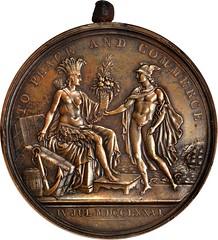 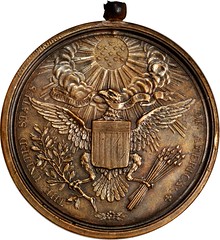
"1776" (1792) United States Diplomatic Medal. Original. Bronze. 67 mm. By Augustin Dupre. Julian CM-15. Specimen-55 (PCGS). Secure Holder. Original ferrous loop intact. One of the rarest and most important of all American medals, with just four specimens known to exist, of which this may be the finest. Conceived in 1790 by Thomas Jefferson, struck in Paris in 1792 from dies by Augustin Dupre, the Diplomatic Medal emerged from the very earliest days of the Republic and its nascent foreign policy. Since the end of the Civil War, collectors have had the opportunity to acquire a specimen of this rarity at public auction just four times, in 1882, 1981, 1990, and 2004. This example has never before been offered in a major American auction. The obverse depicts the first version of the Great Seal of the United States ever executed in medallic form, correctly showing the olive branch of peace at dexter (eagle's right) and the arrows of war at sinister (eagle's left, viewer's right). The eagle holds a banner inscribed with the national motto E PLURIBUS UNUM in his beak and an escutcheon or shield is displayed on his breast. A glory of 13 stars is atop the obverse, and the legend THE UNITED STATES OF AMERICA surrounds the arms at the periphery. On the reverse, an allegory of America, in her common guise as a Native American princess, holds a cornucopia or horn of plenty and gestures to bundles and a hogshead beside an anchor. She is approached by Mercury as Commerce, holding his caduceus. A ship representing Atlantic commerce and interactions with Europe is in his background. The legend TO PEACE AND COMMERCE is appropriate to the scene; the date July 4, 1776 is rendered in Roman numerals in the exergue. Approved by George Washington, influenced by John Adams and William Temple (grandson of Benjamin) Franklin, and brought to fruition by Augustin Dupre, the United States Diplomatic medal was the pet project of Thomas Jefferson. To read the complete lot description, see:
Lot 31: 1874-S Liberty Seated Quarter
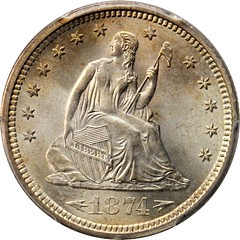 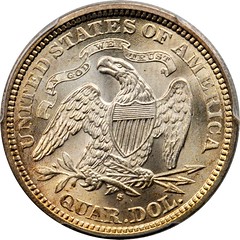
1874-S Liberty Seated Quarter. Arrows. Briggs 3-A. MS-66+ (PCGS). CAC. An exemplary Gem quarter dollar. The broadly sweeping cartwheel luster supports pale champagne-gold that deepens slightly at the rims, especially on the reverse. The strike is bold and sharp throughout with just a touch of lightness to one or two obverse stars. The eye appeal is superb, and the reverse appears nearly matte-like under low magnification. This specimen will definitely be a highlight in its next steward's cabinet. In 1873 the weights of dimes, quarters and half dollars were adjusted upward by a tiny fraction, from 6.22 to 6.25 grams in the case of the quarter dollar denomination. This uptick in weight amounted to just .03 grams, a tiny figure that made very little difference to the "average Joe" in America. Today's numismatists appreciate the associated design change of 1873 to 1874, however, and the Arrows coinage of those dates is eagerly sought by type collectors and quarter specialists alike. Branch mint issues, such as the 1874-S offered here, are the most popular with advanced collectors. To read the complete lot description, see:
Lot 45: 1799/8 Draped Bust Silver Dollar
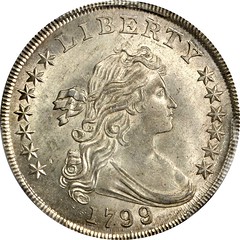 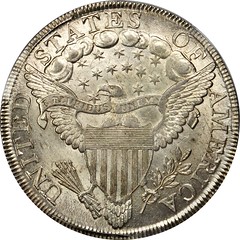
1799/8 Draped Bust Silver Dollar. BB-141, B-3. Rarity-3. 15-Star Reverse. MS-64 (PCGS). This incredible silver dollar is one of the finest known examples of the popular BB-141 die variety. The luster is simply outstanding for a silver dollar of this type, the texture vibrant and satiny over both sides. The strike is no less impressive with uniformly bold borders framing devices that are sharply struck over all but a few isolated features. Indeed, the overall definition is as strong and complete as one could realistically expect in a Draped Bust dollar of any date or variety. Brilliant and highly attractive, this coin would be the centerpiece of a fine early dollar set. Exquisite! BB-141 is one of the most popular and eagerly sought die marriages among 1799-dated silver dollars, combining as it does an overdate obverse die with a reverse die readily recognizable as having a blundered arc star pattern. On the obverse, the final digit 9 in the date has been punched over an 8, remnants of the underdigit quite bold and readily evident even without the aid of a loupe. The reverse exhibits 15 stars above the eagle as opposed to the normal 13, although the additional two stars can be difficult to discern for the uninitiated. They protrude from the first and final clouds, which were enlarged by the engraver to cover most of the extra stars when he realized his blunder. BB-141 is not a major rarity in an absolute sense -- it is actually a fairly plentiful die marriage by 1799 dollar standards -- but in MS-64, as here, the variety is an important condition rarity. To read the complete lot description, see:
Lot 91: Original 1859 Silver Proof Set with Case.

This is one of the most exciting and intriguing offerings in this sale. The late 1850s are an important time in the history of both the United States Mint and the numismatic hobby in this country. Coin collecting in the United States experienced its first major upsurge in popularity toward the end of that decade and, in order to take advantage of increased public interest in numismatics, Mint Director James Ross Snowden began the widespread marketing and sale of Proof coinage in 1858. Yearly mintages of Proof coins reached previously unheard of levels, and beginning in 1859 the Mint recorded the number of Proofs struck for the various silver and gold denominations.
Most Proof 1859 silver coins were acquired individually, and this is especially true for the silver dollar. Given its large size and impressive appearance, the silver dollar was particularly popular with collectors seeking only a single Proof coin of the date. Even so, the Mint did prepare and distribute a small number of minor and silver coin Proof sets in 1859 (along with an even more limited number of complete Proof sets that also included the gold coins). Writing in the 1989 edition of Walter Breen's Encyclopedia of United States and Colonial Proof Coins: 1722-1989, the author states, "The number of such sets made is unknown as yet, though evidently of the order of 60-70 -- perhaps slightly more than 1858, certainly less than 100." Breen further states that most such sets were promptly broken up and, apart from the ex Hesslein offering in a June 1923 auction, all existing sets of which he was aware had been assembled from individual coins in more recent years. Indeed, we know of very few original 1859 Proof sets. The silver coins in Pittman's complete 1859 Proof set from the cent through double eagle (Akers, October 1997, lot 834) constituted an original set, although he acquired the accompanying gold coins individually. The six coins that comprise the present offering are of uniform Choice Proof quality with virtually identical toning and, as such, certainly also represent an original set -- one of very few to have survived intact to the present day. This 1859 Proof set of silver coins seems to represent the way they were distributed, as a group, without minor coins or gold coins. Mint practices varied at the time, and certain cases were made with more denominations. Such encasements were obtained from private manufacturers. Mid-19th century Proof sets in contemporary cases are exceedingly rare. To read the complete lot description, see:
Lot 102: 1848 Liberty Quarter Eagle. CAL.
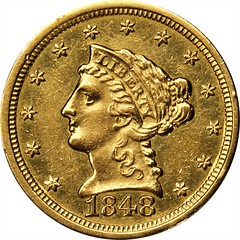 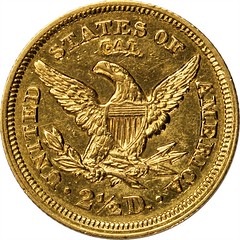
1848 Liberty Quarter Eagle. CAL. AU-58 (NGC). Offered is a sharp and inviting example of this classic rarity with a significant link to the California Gold Rush. Evenly toned in light honey-gold, both sides exhibit a soft satin texture to the devices and modest semi-reflectivity in the fields. This lovely near-Mint survivor is crisply impressed with virtually full definition to all design elements. In 1848 some 230 or so ounces of gold bullion from the recently discovered California gold fields was sent to Secretary of War William L. Marcy by Colonel R.B. Mason, acting military governor of California. Marcy turned the bullion over to the Mint, where it was used to strike some 1,389 quarter eagles. In order to denote the origin of the gold used for this special limited mintage, the letters CAL. were punched into the upper reverse field above the eagle's head on all the specimens struck. This distinguishing feature marks the 1848 CAL. quarter eagle as our nation's first commemorative issue, produced 44 years prior to the 1892 Columbian Exposition half dollar. Given the popularity of the California Gold Rush era with numismatists and other collectors, the 1848 CAL. has long enjoyed strong demand. Indeed, the acquisition of an 1848 CAL. quarter eagle is a defining moment in the formation of any collection. Survivors are scarce, and appearances on the open market are rare, so much so that even the offering of a lower grade example represents an important opportunity. Sharply defined and nearly in the Mint State category, the present coin would serve as a centerpiece in even the finest cabinet. To read the complete lot description, see:
THE BOOK BAZARREWayne Homren, Editor The Numismatic Bibliomania Society is a non-profit organization promoting numismatic literature. See our web site at coinbooks.org. To submit items for publication in The E-Sylum, write to the Editor at this address: whomren@gmail.com To subscribe go to: https://my.binhost.com/lists/listinfo/esylum All Rights Reserved. NBS Home Page Contact the NBS webmaster 
|
